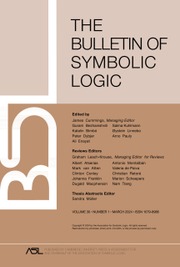No CrossRef data available.
Article contents
UNIVOCITY OF INTUITIONISTIC AND CLASSICAL CONNECTIVES
Published online by Cambridge University Press: 26 December 2024
Abstract
This paper investigates the univocity (or uniqueness) of connectives in intuitionistic and classical sentential logic. Specifically, unlike Gentzen systems, Hilbert systems for (various fragments of) intuitionistic and classical logic do not always determine univocal (or unique) conditional connectives. This paper explains when univocal conditional connectives are achieved in Hilbert systems for intuitionistic and classical sentential logic (and when they are not). In the final section, we discuss the (non-)univocity of the Sheffer stroke in Hilbert vs. Gentzen systems for classical sentential logic.
Information
- Type
- Article
- Information
- Copyright
- © The Author(s), 2024. Published by Cambridge University Press on behalf of The Association for Symbolic Logic
References
Caicedo, X. and Cignoli, R.,
An algebraic approach to intuitionistic connectives
.
The Journal of Symbolic Logic
, vol. 66 (2001), no. 4
, pp. 1620–1636.Google Scholar
Ertola-Biraben, R.,
On univocal connectives
.
Logic and Logical Philosophy
, vol. 19 (2009), no. 1, pp. 5–13.Google Scholar
Frege, G.,
Begriffsschrift, eine der Arithmetischen Nachgebildete Formelsprache des Reinen Denkens
, Nebert, Halle, 1879.Google Scholar
Gentzen, G.,
Investigations into logical deduction
,
The Collected Papers of Gerhard Gentzen
, North Holland, Amsterdam, 1969, pp. 68–131.Google Scholar
Kovács, L. and Voronkov, A.,
First-order theorem proving and vampire
,
Computer Aided Verification
(Sharygina, N. and Veith, H. editors), Springer, Heidelberg, pp. 1–35.Google Scholar
McCune, W.,
Otter 3.3 Reference Manual. Technical Report ANL/MSC-TM-263
, Argonne National Laboratory, Lemont, 2003.Google Scholar
Nicod, J.,
A reduction in the number of primitive propositions of logic
.
Proceedings of the Cambridge Philosophical Society
, vol. 19 (1917), no. 1917, pp. 32–41.Google Scholar
Read, S.,
Sheffer’s stroke: a study in proof-theoretic harmony
.
Danish Yearbook of Philosophy
, vol. 34 (1999), no. 1, pp. 7–23.Google Scholar
Scharle, T.,
Axiomatization of propositional calculus with Sheffer functors
.
Notre Dame Journal of Formal Logic
, vol. 6 (1965), no. 3, pp. 209–217.Google Scholar
Smiley, T.,
The independence of connectives
.
The Journal of Symbolic Logic
, vol. 27 (1962), no. 4, pp. 426–436.Google Scholar
Zach, R.,
Natural deduction for the Sheffer stroke and Peirce’s arrow (and any other truth-functional connective)
.
Journal of Philosophical Logic
, vol. 45 (2016), no. 2, pp. 183–197.Google Scholar


